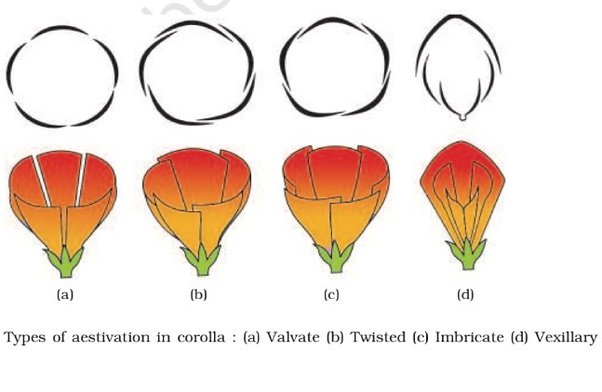MCQ ON AESTIVATION / AESTIVATION class 11 for NEET | AESTIVATION class 11| MCQ AESTIVATION with Answer | Check the below NCERT MCQ question for class 11Biology based on the with Answers.
MCQ on AESTIVATION class 11Biology with answers were prepared based on the latest pattern. We have provided class 11 Biology MCQs question with Answers to help students understand the concept very well.

MCQ ON AESTIVATION / AESTIVATION class 11 for NEET
MCQ ON AESTIVATION is useful for NEET / CSIR / UGC / CBSE / ICSE / AIIMS / EXAM / AFMC EXAM / STATE LEVEL MEDICAL EXAM/ KVS PGT BIOLOGY / NVS PGT BIOLOGY EXAM 2023-2024 ,2025
INTRODUCTION:-
AESTIVATION:-
DEFINITION OF AESTIVATION:- The mode of arrangement of sepals or petals in floral bud with respect to the other member of same whorls is known as aestivation.
The main type of aestivation are valvate, twisted, imbricate and vexillary aestivation.
VALVATE AESTIVATION:- When sepals or petals in a whorl just touch one another at the margin without overlapping as in calotropis , it is said to be valvate aestivation.
TWISTED AESTIVATION:-
If one margin of the appendages overlapse that of the next one and so on us in China rose , ladies finger and cotton it is called twisted estimation.
IMBRICATE AESTIVATION:-
Margin of sepals or petals overlap one another but not in any particular direction as in cassia and gulmohar the aestivation is called imbricate aestivation.
VEXILLARY AESTIVATION:-
In pea and beans flowers there are five petals the largest standard overlaps the two lateral petals wings which intern overlap the two smallest anterior petals keel, this type of aestivation is known as vexillary aestivation or Papilionocaeae aestivation.
MCQ ON AESTIVATION class 11 for NEET/KVS PGT BIOLOGY / NVS PGT BIOLOGY EXAM 2023-2024,2025
1. The mode of arrangement of sepals or petals in floral bud with respect to the other members of same whorls is known as
(a) aestivation
(b) testa
(c) tegmen
(d) valvate
Ans (a) aestivation
2. The main types of aestivation are
(a) valvate
(b) twisted
(c) imbricate and vexillary
(d) all the above
Ans. (d) all the above
3. When sepals or petals in a whorl just touch one another at the margin without overlapping , it is said to be
(a) valvate
(b) imbricate
(c) vexillary
(d) twisted
Ans. (a) valvate
4. Valvate aestivation is found in
(a) calotropis
(b) china rose
(c) cassia
(d) gulmohar
Ans.(a) calotropis
5. If one margin of the appendages overlape that of next one and so on ,it is called
(a) valvate
(b) twisted
(c) imbricate
(d) vexillary
Ans.(b) twisted
6. If the margin of sepals or overlap one another and but not in any particular direction as in, the aestivation is called
(a) imbricate
(b) valvate
(c) twisted
(d) vexillary
Ans.(a) imbricate
7. There are five petals the largest standard over lapse the two lateral petals wings which in turn overlap the two smallest anterior petals , keel this type of aestivation is known as
(a) imbricate
(b) vexillary
(c) valvate
(d) twisted
Ans.(b) vexillary
8. Vexillary aestivation is found in family
(a) solanaceae
(b) Papilionocaeae
(c) brasaaicaceaea
(d) all the above
Ans.(b) Papilionocaeae
9. In pea and bean flowers contain which type of aestivation ?
(a) vexillary aestivation
(b) imbricate aestivation
(c) twisted aestivation
(d) none of the above
Ans. (a) vexillary aestivation
10. Which are examples of imbricate aestivation ?
(a) pea and beans
(b) calotropis
(c) cassia and gulmohar
(d) china rose and cotton
Ans. (c) cassia and gulmohar
11.China rose contains type of aestivation
(a) imbricate aestivation
(b) vexillary aestivation
(c) valvate aestivation
(d) twisted aestivation
Ans.(d) twisted aestivation
12. Lady’s finger contain the type of aestivation
a) valvate aestivation
b) twisted aestivation
c) imbricate aestivation
(d) all the above
Ans . (b) twisted aestivation
13.Twisted aestivation is found in
(a) cotton
(b) maize
(c) pea
(d) orchids
Ans.(a) cotton
14. Vexillary aestivation found in
(a) pea
(b) maize
(c) cotton
(d) gulmohar
Ans. (a) pea
ALSO READ:-
● YOU CAN WATCH BIOLOGY SIR Youtube channel
15. The aestivation found in the corolla of fabaceae is
(a) vexillary aestivation
(b) imbricate aestivation
(c) valvate aestivation
(d) all the above
Ans.(a) vexillary aestivation
16. Howmany keels are there in vexillary aestivation?
(a) 2
(b) 3
(c) 4
(d) 5
Ans.(a) 2







Leave a Comment